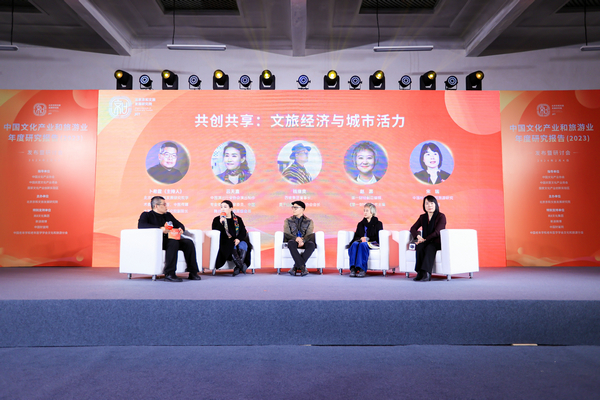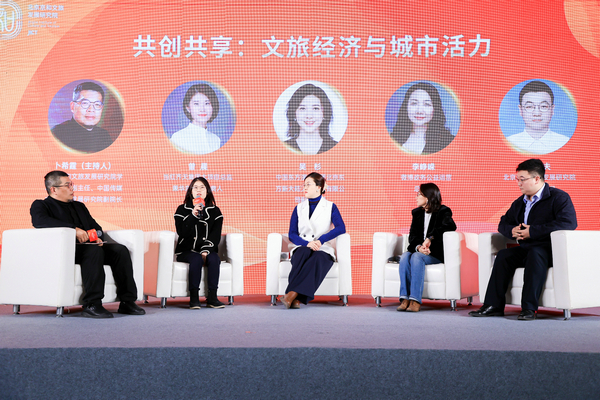
Hou Xuetong, deputy director of the Jinghe Institute of Culture and Tourism, revealed
The Annual Research Report on China’s Cultural Industry and Tourism (2023) in Beijing, on February 4, 2024. [Photo by Yang Xiaoyu/chinadaily.com.cn]
From the barbecue craze in Shandong’s old industrial town of Zibo to the village soccer league frenzy in Guizhou’s obscure Rongjiang County to the ice and snow mania turning Heilongjiang’s Harbin into the hottest winter destination, 2023 has seen an explosive cultural revival culture of China tourism industry giving birth to many phenomena online and offline.
These phenomena are presented in The Annual Research Report on China’s Cultural Industry and Tourism (2023)published Sunday in Beijing by the Jinghe Institute of Culture and Tourism, a think tank specializing in China’s culture and tourism industry.
The 2023 report marks the institute’s third endeavor to shed light on the country’s recent development in the field of culture and tourism for relevant stakeholders.
The report launched the Jinghe Cultural Tourism Economy Index, a tool created by the think tank to measure the development of cultural tourism in China’s provinces, municipalities and autonomous regions based on 34 indicators of three dimensions – availability of resources, coordination of enabling elements and the result of economic and social benefits.
Beijing leads the Jinghe index, followed by Zhejiang Province, Shanghai, Jiangsu Province and Guangdong Province.
The index aims to provide a nuanced understanding of regional strengths and opportunities and offer a benchmark for policy formulation and strategic planning in the cultural tourism sector, according to the institute.
“The Jinghe Index can offer a new perspective for local governments and industry practitioners to understand the various logical connections between the supply side and the demand side of the cultural tourism industry,” noted Li Qian, director of the National Cultural Industry Steering Committee. Experimental zone for innovation, during the presentation of the report.
Like the previous two reports, the 2023 edition includes a comprehensive analysis of sector trajectories over the past year, a summary of the ten hottest developments in the two increasingly integrated industries based on data from social platforms, and a forecast of ten industry trends through 2024
In 2023, China’s cultural and related industrial enterprises that are above the specified size number about 73,000, an increase of 5.8 percent year-on-year, and operating income of 12.9515 trillion yuan ($1.82 trillion ), calculated on a comparable caliber basis, was up 8.2 percent year-over-year, a growth rate significantly higher than that of the past five years, the report said.
He also pointed out that pent-up consumer demand in tourism has led to a rapid recovery in travel, while digitalisation and related innovations have fueled tourism development over the past year. In 2023, China’s CTA-TEP, an index measuring the development of its tourism economy, returned to the “boom” range, averaging 109.95, close to the level of the same period in 2019, but the number of tourist trips and revenues in the first three quarters were lower than the 2019 level.

The launch event of
The Annual Research Report on China’s Cultural Industry and Tourism (2023)
Held in Beijing on February 4, 2024, includes two round tables on cultural tourism and urban vitality. [Photo provided to chinadaily.com.cn]
The ten trends that will shape China’s cultural tourism sector in 2024 predicted by the report resonated with attendees at the launch event.
The report argues that cultivating new growth points with new business formats is the key to achieving sustainable development of the cultural tourism industry in the new year, and the pursuit of a low carbon footprint and sustainability will become a sector-wide consensus.
Artificial intelligence-generated content, or AIGC, will enable the entire industry chain in 2024, and experience-oriented cultural tourism products that bring people emotional value will gain more market traction, according to the report.
In addition, according to the report, more cultural tourism products with excellent traditional Chinese cultural elements will appear in the new year, rural tourism plays a greater role in coordinating urban and rural economic development, and the silver generation, which has more time and purchasing power, contribute more to the growth of the cultural tourism sector.
The launch event also featured two roundtable discussions on cultural tourism and urban vitality attended by industry figures.
A key academic brand of the Jinghe Institute of Culture and Tourism, the report, published in Chinese and English, was written by a group of researchers led by Fan Zhou, director of the institute; Qi Ji, deputy director of the institute; and Jia Xudong, director of the institute’s academic committee.

The launch event of
The Annual Research Report on China’s Cultural Industry and Tourism (2023)
Held in Beijing on February 4, 2024, includes two round tables on cultural tourism and urban vitality. [Photo provided to chinadaily.com.cn]

